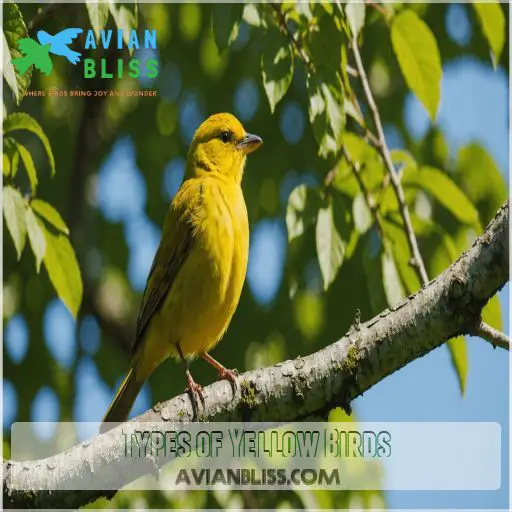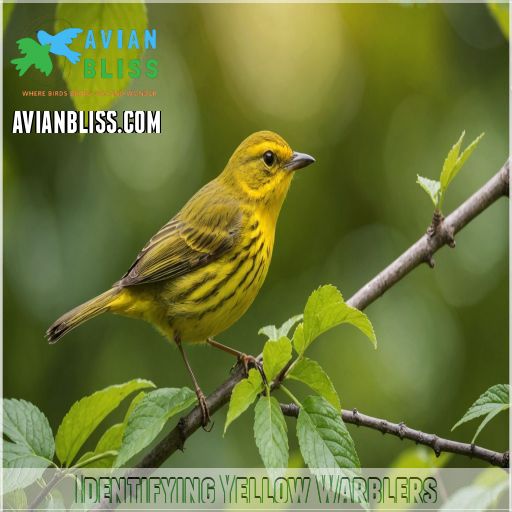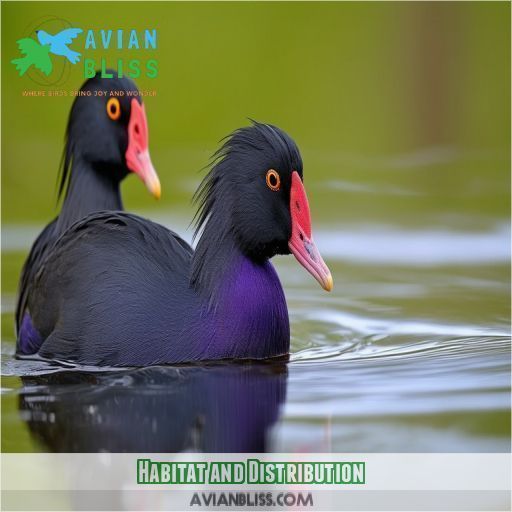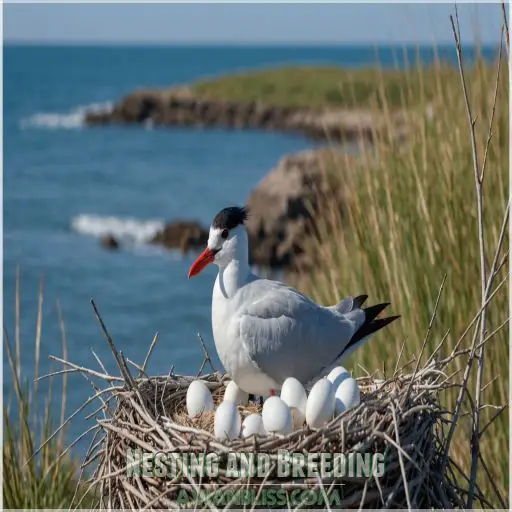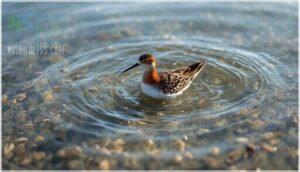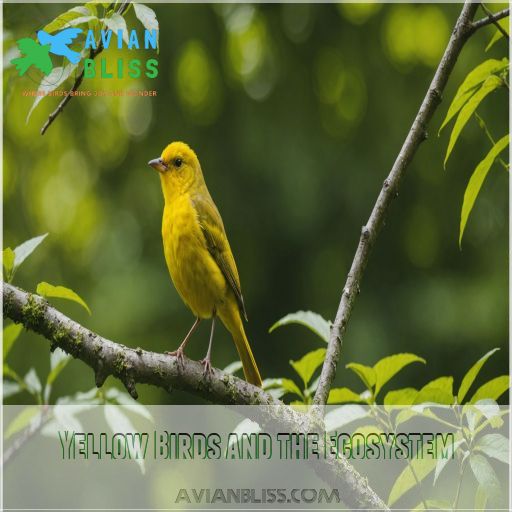This site is supported by our readers. We may earn a commission, at no cost to you, if you purchase through links.
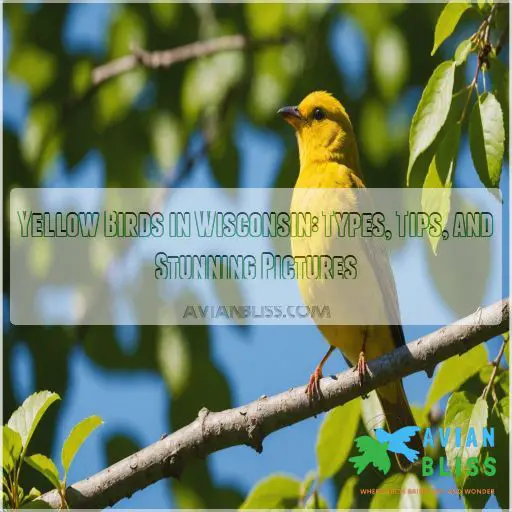
Brood parasitism by Brown-headed Cowbirds keeps it on its toes, leading to some creative defenses.
While these yellow gems brighten any habitat, they’re facing challenges from habitat loss and climate change.
Stay tuned for tips on attracting these avian wonders to your backyard and supporting their conservation!
Table Of Contents
- Key Takeaways
- Types of Yellow Birds
- Identifying Yellow Warblers
- Habitat and Distribution
- Nesting and Breeding
- Diet and Foraging
- Common Yellow Birds in Wisconsin
- Migration and Seasonal Patterns
- Yellow Birds and Backyard Feeders
- Conservation and Threats
- Yellow Birds and the Ecosystem
- Frequently Asked Questions (FAQs)
- What is a yellow bird in Wisconsin?
- What is the most common yellow bird?
- What are the little yellow birds called?
- What does a yellow warbler look like?
- What are the behavioral patterns of yellow birds?
- How do yellow birds communicate with each other?
- What adaptations do yellow birds have for survival?
- Are there any cultural significances to yellow birds?
- How do weather conditions affect yellow birds?
- Conclusion
Key Takeaways
- When you’re out exploring Wisconsin’s wetlands and forests, you’ll love spotting vibrant yellow birds like the yellow warbler and american goldfinch. They’re like sunshine with wings, bringing color and joy while playing essential roles in insect control and seed dispersal. So, grab your binoculars and enjoy nature’s live show!
- Want to attract these golden guests to your backyard? It’s easier than you think! Just hang up some feeders with nyjer and sunflower seeds, provide fresh water, and add a few native shrubs. Create a birdie buffet that even the pickiest feathered friends can’t resist.
- These bright birds face big challenges, including habitat loss and brood parasitism. But don’t worry—you can make a difference! Your backyard can be a sanctuary for them by planting native plants and maintaining clean birdbaths.
- Remember, when these flitting flashes of yellow sing, they’re not just serenading you; they’re communicating vital information with their pals. It’s an avian symphony right in your own backyard, and you’re the lucky audience member!
Types of Yellow Birds
You’ll love the vibrant world of yellow birds in Wisconsin, as these sunny creatures brighten up your day and the forests!
From the cheerful American Goldfinch to the sneaky Common Yellowthroat, learning about these feathered wonders can be as thrilling as finding a french fry at the bottom of your fast-food bag.
Yellow Warbler
Yellow Warbler, or Setophaga petechia, captivates with its vibrant plumage and delightful songs.
You’ll spot these feathered wonders flitting through Wisconsin thickets, embodying freedom with every flap.
Enthusiastic nest builders, they craft cozy homes, thwarting cowbird intrusions ingeniously.
Yet, conservation efforts are essential, as habitat threats loom.
Spotting this charming bird reaffirms life’s simple joys—let them sing your worries away!
American Goldfinch
Picture it: A splash of sunshine flitting through your backyard. That’s the American Goldfinch, a delightful presence among yellow birds in Wisconsin. Their diet of seeds keeps them singing all summer.
During molting, males lose their bright plumage, turning a humble brown.
Goldfinches enchant with their flighty antics near feeders, blending beauty and energy effortlessly, like nature’s little comedians.
Yellow-Headed Blackbird
Catch a glimpse of the striking yellow-headed blackbird as it graces the wetlands of Wisconsin!
These bold beauties sport a vibrant yellow head, chest, and belly, contrasting sharply with their jet-black wings and tail.
Listen for their distinctive "conk-a-ree" call as they forage for seeds and insects among the reeds.
Keep an eye out – you might just spot one on your next birding adventure!
Common Yellowthroat
Ah, the Common Yellowthroat is a lively yellow-bellied bird that serenades you with its sharp song!
Preferring marshy habitats, these tiny warblers flit among the reeds.
Their charming "witchety-witchety" song is distinctive.
Nesting low in dense vegetation, these birds passionately guard their territory.
Embrace their lively presence and consider conservation efforts to help these spirited warblers continue thriving.
Prothonotary Warbler
Like the elusive Common Yellowthroat, the Prothonotary Warbler enchants with its bright yellow breast and melodic song.
This stunning bird prefers wetland habitats, often spotted flitting near water.
Conservation efforts aid its survival, as habitat loss poses ongoing challenges.
Passionate bird enthusiasts adore capturing its vivid beauty in bird photography, celebrating this "golden gem" alongside fellow warblers like the blue-winged and Nashville.
Identifying Yellow Warblers
Spotting a Yellow Warbler isn’t just about their vibrant color; you’ll need to listen for their sweet whistles and observe their sleek, petite frames in places like willow thickets.
They’re like little streaks of sunshine, flitting about with a purpose, making you wish you could bring them home for dinner—you’d just have to serve up a heaping plate of insects!
Plumage and Coloration
Spotting yellow warblers in Wisconsin? You’ll want to know their plumage and coloration details! Here’s the scoop:
- Bright Yellow Feathers: Both males and females flaunt this, but males have chestnut streaks.
- Molting Patterns: They molt after breeding, changing slightly.
- Plumage Evolution: Adapted to blend into blooming sunny thickets.
Perfect for ducking brown-headed cowbirds or matching a Kirtland’s warbler!
Song Patterns and Vocalizations
After admiring their plumage, tune into the symphony of Yellow Warblers as they serenade you with cheerful songs.
You’ll notice fascinating song variations reflecting geographic differences.
Beware of bird calls with vocal mimicry traits, often surprising!
Keep your ears perked for seasonal changes in their melodies.
Each warbler’s unique tune adds magic to nature’s grand orchestra, making birdwatching delightful.
Size and Body Structure
Now, let’s explore their size and body structure.
Yellow Warblers are small, around five inches long with a wingspan of about eight.
Their compact body and short tail give them agility akin to a ballet dancer in flight.
With a slender bill perfect for snagging insects, and distinct feather patterns, they’re like nature’s little yellow sunbeams zipping around!
Nesting Habits and Habitat
In the lush, shrubby habitats they call home, Yellow Warblers construct delicate cup-shaped nests about 10 feet off the ground.
Using grasses, plant fibers, and spider webs, the females weave these cozy abodes, often lining them with soft materials like deer hair and cottonwood fluff. Look for these nests near willows and other small trees – the perfect spots for raising their young.
- Nest-building materials: Grasses, plant fibers, spider webs
- Nest site selection: 10 feet off the ground, near willows and small trees
- Habitat preferences: Wet, shrubby areas, early successional habitats
- Brood parasitism: Targeted by Brown-headed Cowbirds, leading to multi-tiered nests
Habitat and Distribution
Discover where Wisconsin’s yellow birds call home, with lush wetlands and vibrant forests providing them the perfect backdrop for breeding and migration.
You’ll love knowing their favorite spots and food sources, ensuring your birdwatching efforts don’t fly south for the winter!
Breeding Grounds in Wisconsin
Identifying Yellow Warblers might feel like spotting sunshine on wings. Wisconsin’s breeding grounds are their paradise! These birds love wetlands, especially those draped in willow thickets.
Let’s explore:
| Feature | Yellow Warbler Trait |
|---|---|
| Nesting Season | Spring and Summer |
| Habitat Preferences | Wet deciduous thickets |
| Conservation Efforts | Preserve wetland areas |
| Nest Parasitism | Threatened by cowbirds |
Enjoy their vibrant hues!
Migration Patterns
Migration often seems like a marathon for yellow warblers, following routes from Wisconsin to Central and South America.
Timing is key—leave too late, and it’s a wild goose chase through storms.
These small travelers face challenges like harsh weather and predators, yet their success impacts ecosystem harmony.
You can’t help but root for these tiny adventurers!
Preferred Food Sources and Foraging Habits
Foraging for insects and wild fruits is the name of the game for these vibrant yellow warblers.
You’ll often spot them darting between branches, snatching up tasty morsels mid-flight.
Their diverse diet includes:
- Caterpillars, beetles, and other juicy bugs
- Berries from shrubs and small trees
- Nectar from flowering plants
- Seeds and grains from the forest floor
Their active, acrobatic foraging style is a delight to observe!
Wetland and Forest Habitats
Just as you marveled at their quirky feeding antics, imagine strolling through Wisconsin’s lush wetlands and dense forests, where nature’s show unfolds.
These habitats are a paradise for yellow birds like warblers and goldfinches, such as those found in Arizona like warblers and goldfinches.
Sadly, habitat loss threatens these avian jewels.
Conservation efforts and birdwatching tips will have you feeling like a superhero for these delightful forest and wetland dwellers.
Nesting and Breeding
In Wisconsin, you’ll find that yellow birds like the Yellow Warbler build nests using an enchanting mix of grasses, bark, and even spider webs.
The tenacious females expertly handle construction duties, deftly managing challenges such as dealing with freeloading Brown-headed Cowbirds that try to leave their eggs in the nest—these cunning birds don’t have a chance against mother warbler’s creativity and persistence!
Nest Construction and Materials
As the vibrant Yellow Warblers settle into their summer habitats, it’s fascinating to watch their architectural skills.
They carefully construct cozy nests using:
- Nest materials like grasses, plant fibers, and even spider webs.
- Finding the perfect nest location about ten feet up in the shrubs.
- Ensuring the nests are ready to face nest predators and changing weather—a true feathered fortress!
Female Warblers’ Roles in Nesting
As the female Yellow Warbler constructs her cozy cup-shaped nest, she’s the star of the show.
She carefully weaves grasses, fibers, and spider webs, lining the interior with soft materials like deer hair and fluffy cottonseeds.
While her mate may bring food, she’s the sole incubator, patiently sitting on the eggs until they hatch.
Brood Parasitism and Brown-Headed Cowbirds
Brood parasitism by Brown-headed Cowbirds is like an unwelcome guest at the Yellow Warbler’s nest party. Yellow Warblers, with their knack for cowbird egg recognition, sometimes build new nests over the intruder’s eggs—a clever nest defense strategy!
Unfortunately, brood parasitism impacts Warbler populations, leading to fascinating evolutionary dances.
Conservation efforts are essential in helping these colorful warblers thrive.
Average Clutch Size and Number of Broods
You’ve just learned about the sneaky Brown-headed Cowbird, but let’s chat about the Yellow Warbler’s nesting success.
Typically, these songbirds lay 4-5 eggs per brood, raising one to two broods each season.
Nesting habitat and brood parasitism impact brood size variation a lot.
Every season, the warblers face challenges, but their determination means their cheerful singing continues delighting bird enthusiasts.
Diet and Foraging
Get ready to explore how Wisconsin’s vibrant yellow birds satisfy their appetites—whether they’re munching on insects, savoring fruits, or even sipping flower nectar in the most gymnastic of ways!
You might spot these winged wonders engaged in acrobatic maneuvers as they chase after unruly bugs or diligently scour the ground for scrumptious snacks—aerial foraging and ground foraging at its finest.
Primary Food Sources (Insects, Fruits, Etc.)
The Yellow Warbler’s diet is quite diverse, ranging from insects to wild fruits.
These little birds are voracious insect-eaters, snatching up caterpillars, beetles, and more to fuel their high-energy lifestyles.
When fruits like berries and cherries are in season, they’ll happily supplement their meals with these tasty morsels too.
It’s a delicate balancing act, but these adaptable birds make the most of the bounty nature provides.
Active Foraging Techniques
Warblers have a knack for active foraging techniques, zigzagging through habitats like a culinary adventure.
They’ve got a real flair for food selection, capturing prey in action-packed sequences.
Picture them executing their unique insect hunting strategies, darting between leaves with precision.
It’s like nature’s reality TV show, showcasing their adaptability and boundless energy in every scene!
Ground-Foraging Vs. Aerial Foraging
From flitting mid-air to snatching a snack off the ground, these yellow warblers showcase diverse foraging techniques.
Think of them as nature’s acrobats—mastering both ground vs. air maneuvers.
Here’s what influences their choice:
- Insect types
- Seasonal abundance
- Vegetation structure
- Safety from predators
Each factor impacts survival, turning foraging into both art and necessity.
Drinking Nectar From Flowers
Ever wondered why yellow birds don’t just stick to insects?
They love nectar too, competing with hummingbirds like it’s some secret dance-off.
They’re picky about their flower preferences, favoring nectar-rich blooms and even your feeders.
This charming plant-bird relationship balances nature’s dance, adding buzz and beauty to your garden ecosystem, making every day a splash of freedom and nectar!
Common Yellow Birds in Wisconsin
As you’ve learned, the Yellow Warbler is a true showstopper, but they’re not the only vibrant yellow birds gracing Wisconsin’s skies. Let’s take a closer look at some other common feathered friends you might spot around your neck of the woods:
- American Goldfinches – These cheerful little finches are a backyard staple, flitting from feeder to feeder in their sunny plumage. Attract them with nyjer seed and watch their acrobatic antics up close.
- Yellow-Headed Blackbirds – Boasting a bold black body and vivid yellow head, these striking birds are often found near marshes and wetlands, their loud, gurgling calls echoing across the water.
- Common Yellowthroats – Peek through the undergrowth and you might catch a glimpse of this warbler’s bright yellow throat and distinctive black mask, as it hops and flits through the vegetation.
With so many vibrant options, Wisconsin’s yellow birds are sure to brighten up your day, no matter where you look.
Migration and Seasonal Patterns
As you watch the seasons change in Wisconsin, you’ll notice these vibrant yellow birds on their incredible migratory journeys.
It’s like a feathered version of rush hour as they travel north for the summer and head south for the winter, each season bringing its own avian excitement!
Spring Migration
During spring migration, yellow birds in Wisconsin take a journey akin to a bordered map adventure, using precise migration routes that amaze even seasoned birdwatchers.
Timing variations among species delight citizen scientists keen to compare notes.
Birdwatching tips suggest early mornings are golden hours. Join the vibrant community, sharing stories and possibly spotting these feathered tourists before summer settles in.
Summer Breeding
Warblers take a break from spring migration, focusing on summer breeding. Nest site selection is critical, with males helping in feeding.
Timing of breeding affects success rates, with females laying 4–5 eggs:
- Female solo incubates, males nearby
- Brood size impacts survival
- Abundant insects support fledgling growth
It’s an avian summer camp—busy, lively, and utterly charming!
Fall Migration
As the days grow shorter, you’ll notice the Yellow Warblers start to disappear from your backyard.
These vibrant songbirds set off on an incredible journey, flying thousands of miles to their wintering grounds in Central and South America.
Keep an eye out for them during fall migration – you might spot them fueling up at your birdbath before their long trip south.
Wintering Grounds and Habitat
Packing up for winter? These yellow warblers may feel the chill too, as they head south to balmy and cozy wintering grounds. Here’s the insider scoop:
- Climate Change: Watch its impact on migration routes.
- Food Sources: A buffet makes winter more delightful.
- Population Trends: Ebb and flow along the journey.
- Habitat: Cozy southern spots for resting those feathers.
Yellow Birds and Backyard Feeders
If you want to create a bustling bird paradise in your backyard, luring in vibrant yellow birds like the cheerful American Goldfinch or a curious Yellow Warbler, you should focus on feeder strategies and habitat enhancements.
Hanging feeders with sunflower seeds and providing fresh water sources signal a high-class avian restaurant, all to impress those golden guests.
Attracting Yellow Birds to Feeders
You might find these vibrant yellow birds flocking to your backyard if you create the right atmosphere. Feeder placement can make all the difference. Here’s a quick guide:
| Aspect | Tips |
|---|---|
| Feeder Placement | Try hanging feeders in quiet areas. |
| Water Sources | Add a bubbling fountain or bird bath. |
| Bird Bath Design | Keep it shallow and clean regularly. |
| Landscaping | Plant shrubs for shelter and perches. |
Seed Types and Preferences
Attracting yellow birds to your backyard is a breeze with the right seed mix, like a nyjer and sunflower seed blend.
Nyjer, sunflower, and safflower seeds are their favorites, providing essential nutrients and energy.
Opt for high-quality seed blends that cater to their preferences, and you’ll soon have a vibrant, chirping chorus in your garden.
Just remember to keep those feeders well-stocked!
Bird Baths and Water Sources
Ever seen a yellow warbler enjoying a splash?
Providing water sources like bird baths can attract these lively visitors.
Keep it fresh—cleanliness is next to birdliness, after all!
Opt for a shallow bath with perches.
The gentle trickle of a fountain can be music to a bird’s ears, inviting them in for a cool dip and drink.
Landscaping for Yellow Bird-Friendly Habitats
With bird baths in place, think about landscaping like a chef crafting a garden salad. Mix native plants with tasty morsels for yellow friends. Here’s how:
- Native Plants: Add natural spice.
- Bird Bath Placement: Strategically sprinkle.
- Predator Protection: Protect your culinary creation.
- Food Sources: Feast on footing.
Create a vibrant avian haven!
Conservation and Threats
You might think the bright colors of yellow birds in Wisconsin mean they’re thriving, but these cheerful feathered friends face real challenges.
With threats like habitat loss and brood parasitism looming, protecting their homes isn’t just for the birds—it’s for us too!
Population Decline and Threats
Sadly, Yellow Warbler populations have been steadily declining in recent decades.
Habitat loss, climate change, pesticides, disease, and competition from invasive species all threaten these vibrant songbirds.
But don’t lose hope – with your help, we can protect the places they call home and make sure their future soars bright.
Every backyard counts!
Habitat Conservation and Preservation
Population’s been declining, and you might wonder how to help.
Consider wetland restoration—it’s like giving these yellow beauties a new lease on life!
Fight invasive species chomping down their habitats.
Climate change isn’t just hot air; it affects their homes too.
Try bird banding or join citizen science projects.
Every little bit helps these feathered friends thrive!
Impact of Brood Parasitism
Brood parasitism, especially by pesky cowbirds, can be quite the hurdle for our lovable Yellow Warblers.
They’ve got some clever tricks, though—like recognizing cowbird eggs and piling new nests atop old ones!
While this impacts warbler populations, it also sparks host defense innovations.
Thankfully, conservation efforts play a starring role in easing these avian dramas.
Climate Change and Its Effects
Climate change stirs the pot for yellow birds in Wisconsin, affecting their habitat and lifestyle.
You’ve probably noticed these feathered friends facing:
- Habitat loss: Deforestation and urban sprawl shrink their cozy spots.
- Migration shifts: They’re confused, like office workers without coffee.
- Food scarcity: Fewer insects mean fewer snacks, impacting breeding success.
Keep an eye out for these population trends!
Yellow Birds and the Ecosystem
Yellow birds play a key role in the ecosystem, acting as natural pest control by feasting on insects and helping to disperse seeds.
As you observe these vibrant creatures flitting through your backyard, you’ll appreciate how they contribute to the delicate balance of nature and enrich our shared environment.
Roles in Insect Control and Seed Dispersal
In nature’s symphony, yellow birds like the Yellow Warbler play an important role in controlling insects and dispersing seeds, ensuring ecosystem balance. They munch on pesky bugs and drop seeds, planting tomorrow’s forests. Imagine them as nature’s little gardeners!
Here’s a quick look:
| Role | Bird |
|---|---|
| Insect Control | Yellow Warbler |
| Seed Dispersal | American Goldfinch |
| Ecosystem Balance | Common Yellowthroat |
Bird conservation helps keep this vibrant cycle humming.
Interaction With Other Bird Species
You’ve just seen their role in nature’s bug control and seed spreading, now picture their social life.
These yellow birds are like the neighborhood team players, balancing competition and cooperation, engaging in playful territoriality contests.
At nesting time, they either buddy up with friends or bravely fend off predators, showing off that delightful mix of charm and grit.
Ecological Balance and Yellow Birds
Yellow birds, like the charming Yellow Warbler, keep nature in balance — think of them as nature’s quirky pest control team.
They munch on insects, controlling populations, and help spread seeds, enhancing bird diversity.
With habitat loss lurking and climate’s impact growing, these vibrant feathered friends are integral to ecological harmony, cheerfully singing “we’ve got this!” as they flutter along.
Impact on Human Environment
Countless yellow birds play a key role in our ecosystems, providing natural pest control and seed dispersal that benefit both rural and urban environments. Their presence can even influence agricultural productivity and enhance the beauty of our backyards. By welcoming these vibrant creatures, you’ll discover how they enrich our world in remarkable ways:
- Natural Pest Management
- Seed Dispersal and Plant Growth
- Backyard Aesthetics and Enjoyment
- Ecological Indicators of Environmental Health
Frequently Asked Questions (FAQs)
What is a yellow bird in Wisconsin?
Ah, the Yellow Warbler – a vibrant feathered friend that graces Wisconsin’s skies!
These cheerful songbirds flit through lush thickets, their bright plumage a delight to behold.
Keep an eye out for their distinctive chestnut-streaked chests during spring migration.
What is the most common yellow bird?
You’re likely thinking of the American Goldfinch, a favorite in backyards.
Sporting a dazzling yellow hue, it’s like nature’s little sunshine.
These beauties adore sunflower seeds and will charm you with their vibrant energy and playful antics!
What are the little yellow birds called?
You’ve probably seen charming little yellow birds flitting about—they’re likely American Goldfinches or Yellow Warblers.
These cheerful birds brighten your day with their vibrant hues, making you feel like you’re on a perpetual sunny vacation.
What does a yellow warbler look like?
Imagine a sunbeam with wings—Yellow Warblers flash vibrant yellow plumage, accented with large black eyes.
Males add rusty chest streaks, making them stand out like little sunlit mirages in their shrubby, wet woodland habitats.
What are the behavioral patterns of yellow birds?
Yellow birds like the American Goldfinch are active foragers, darting from feeder to feeder in search of seeds and nectar.
They’re social creatures, often flocking together during migration to find the best food sources.
Their cheerful songs brighten any backyard.
How do yellow birds communicate with each other?
When these bright birds chat, it’s like a symphony of chirps!
They use melodious songs and calls to woo mates, defend turf, and warn pals of danger.
It’s a cheery bird banter that keeps their world buzzing.
What adaptations do yellow birds have for survival?
Yellow birds thrive with exceptional vision for spotting predators, vibrant plumage for mate attraction, and versatile diets to weather changing seasons.
Like a Swiss Army knife, these adaptations mean their song fills the skies year-round.
Are there any cultural significances to yellow birds?
Culturally, yellow birds often symbolize joy, optimism, and creativity across different cultures, much like the sun brightens your day.
In literature and art, they represent freedom and happiness, inviting you to embrace life’s vibrant, colorful possibilities.
How do weather conditions affect yellow birds?
As the seasons shift, yellow birds dance with the wind, their vibrant plumage a beacon of resilience.
Whether basking in summer’s warmth or weathering winter’s chill, these feathered friends adapt, reminding us to embrace life’s ever-changing rhythms.
Conclusion
Did you know that over 400 species of birds have been recorded in Wisconsin?
When searching for yellow birds in Wisconsin, you can truly connect with nature and make a meaningful impact.
By understanding their habits and habitats, you’ll help these vibrant creatures thrive.
Plant native shrubs, offer diverse seeds, and keep birdbaths clean.
Let your backyard be a haven for these delightful birds.
Embrace your role as a conservationist—it’s rewarding and important!

